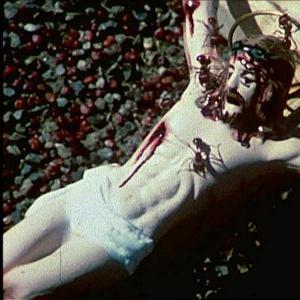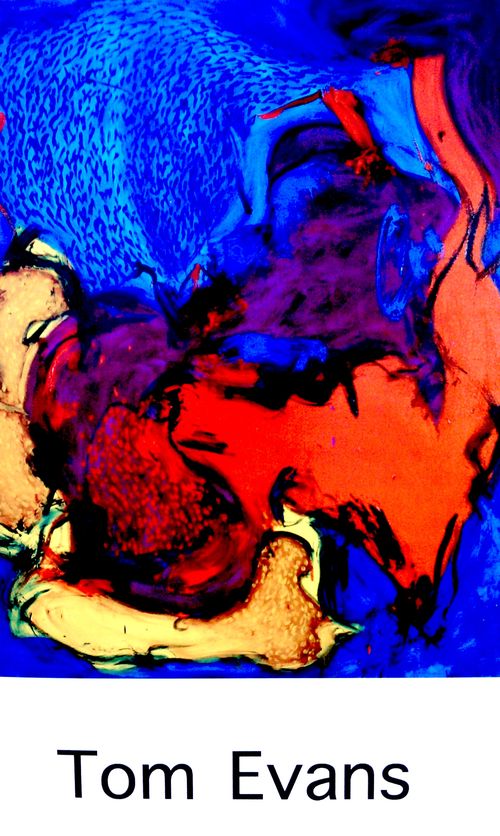
Georges Braque, Still Life with Guitar (Red Tablecloth) (1936) © 2011 Artists Rights Society (ARS), New York / ADAGP, Paris
THE NEW CRITERION
November 2011
Gallery Chronicle
by James Panero
On “Georges Braque: Pioneer of Modernism” at Acquavella Galleries; “Ronnie Landfield: Structure and Color” at Stephen Haller Gallery; “Melissa Meyer: New Paintings and Watercolors” at Lennon, Weinberg, Inc.; & “Melissa Meyer: Just Painting” at BravinLee Programs.
In the development of Cubism, Georges Braque said that he and Picasso were like “two mountain climbers roped together.” Braque should have cut the cord when he had the chance. For a century, Braque has been bound up in the pictorial innovations he developed with Picasso. Even today, the association is hard to shake.
While there have been plenty of joint Picasso-Braque exhibitions, over twenty years have passed since the last major Braque-only retrospective in a U.S. museum. That one was at the Guggenheim in 1988, but don’t look for a museum today to make up for lost time. “Georges Braque: Pioneer of Modernism,” an exhibition of forty paintings and papiers collés now on view at Acquavella, is a product of the commercial gallery system. It is also a triumph. Free to the public, this museum-quality show is the best argument going that one does not have to pay the outrageous admission charges of today’s museums to see great art in New York.
“People were happy to be consumed,” Paloma Picasso once claimed of her father. “They thought it was a privilege.” In their climb up Parnassus during those heady years before the outbreak of World War I, Braque was the brains behind Cubism’s pictorial innovation, and Picasso ate those brains for lunch. Picasso’s appetites have always dominated the narrative. His bed games have become even more legendary than the paintings, thanks to the multi-volume biography by John Richardson. It is from Richardson, for example, that we learn Picasso once claimed to have an eye at the end of his penis.
While Braque was nearly killed at the Front, Picasso lived it up during the war years. After the war, the priapic Andalusian further indulged his cravings. “For the rest of Picasso’s life sex would permeate his work almost as Cubism did,” Richardson claims, and Picasso and Braque went their separate ways. So while Picasso painted from his trousers, Braque turned somewhere else. Braque looked to convention, and in particular to still life. He dedicated his artistic practice to the radical conventions of modernism first uncovered by Cézanne and further developed through analytic and synthetic Cubism. “All of us come from Cézanne,” Braque said. “Cézanne has overthrown centuries of painting.”
The Acquavella show demonstrates the rigor of Braque’s career-long look into the nature of representation. The exhibition begins with Braque’s exploration of Fauvist color that he developed soon after observing Henri Matisse and André Derain at the Salon d’Automne in 1905. In works like L’Estaque (1906), which rivaled anything the other Fauves could do, Braque’s interest in flatness is readily apparent. The eye-popping scene of a curving waterfront and hillside appears to come out of the painting as much as it recedes from view.
The curator Dieter Buchhart has done a masterly job of selecting and hanging this exhibition, with works on loan from both major museums and private collections. For example, between Landscape at L’Estaque (1906) and Houses at L’Estaque (1907), two works side-by-side and of similar scenes, Braque’s transition from Fauvist color to Cubist facet is unmistakable. In the exhibition’s second room, Braque’s move between 1911 and 1912 from the paintings of analytic Cubism to the collages of synthetic Cubism is also easy to see, if not necessarily to comprehend. The exhibition’s catalogue offers some explanation, especially the revealing essay by Richard Shiff of the University of Texas on Braque’s mind-bending ideas of what it means to paint objects in space.
From Fauvism forward, Braque sought “to touch the thing and not only to see it,” as he once said of representation. (He almost always spoke in aphorisms.) In developing Cubism, a movement derisively coined by the critic Louis Vauxcelles after seeing one of Braque’s paintings in 1908 and declaring it to be full of little cubes, Braque painted “from the background planes forward.” He built his scenes out from the picture plane rather than in. Shiff calls this “planar projection—a kind of perspective in reverse.” Braque gave special consideration to touch and the relationship among objects. “I do not believe in things; I believe only in their relationship,” he claimed. “For things to exist, there must first come into being a relationship between you and the things, or between the things themselves.”
Unlike Futurism, which often depicted movement inside a picture, Braque’s still lifes stay still while the viewing perspective moves around them. We become animated rather than the objects inside the frame. Something similar occurs in the collage of synthetic Cubism, another Braque innovation. “I brought sculpture into the canvas,” he said of pasting newspaper, fake wood grain, and corrugated cardboard in his compositions. These additional layers pushed further into viewer space, confounding our distinctions between what is depicted and what is real.
Braque certainly shines on his own. Yet for all of Picasso’s welcome absence from this survey, one last comparison between the artists may be in order. With “Mosqueteros,” the exhibition held at Gagosian gallery in 2009, Picasso’s late paintings, long dismissed, received new and widespread attention. While Acquavella has not billed “Pioneer of Modernism” as a late-period show, this exhibition appears to come out of a similar strategy. Of the four exhibition rooms, the two on the main floor are dedicated to Braque’s later work from the 1920s, 1930s, and 1940s. The start of the exhibition, in fact, begins upstairs. Part of this may be due to size. Braque’s later canvases are generally larger and show better in the ground-floor rooms. But the preponderance of later work also calls out for our attention and reevaluation.
Certainly Braque’s later still lifes are more lyrical and less exacting than the work from the 1900s and 1910s. Yet the show wisely places them in line with his earlier innovations. Touch is still at the forefront. Over several years after World War I, even as modern art retreated from the rapid changes of the pre-war years, Braque soldiered on with innovation, mixing sand and charcoal into his oils to give his surfaces greater tactility. Here objects appear to fly out of the picture plane. Studio V (1949–50) looks like an oncoming picket line of palettes and easels, although a central bird figure, a recurring motif that he later used when commissioned to paint a ceiling at the Louvre, oddly resembles roadkill. Still Life with Guitar I (Red Tablecloth) (1936), one of the most compelling from this period, has everything coming forward: the wainscotings on the walls, the patterns of the wallpaper, the table surface, the tipped bottles and fruit dishes. And there’s color—reds, greens, yellows—a taste of those bold colors Braque deployed as a Fauve.
Is it enough? Probably not. Braque took a lifetime exploring paint. It will take a generation more dedicated to painting than ours to rediscover it.
What does it mean when the best work in an exhibition is the smallest but also the latest? In the case of Ronnie Landfield, a “lyrical abstractionist” whose paintings were recently on view at Stephen Haller Gallery, it means clearing out outmoded ideas in favor of new clarity and focus. Like the sculptor Peter Reginato, his teenage friend who also came of age in the youth movement of the 1960s, Landfield has spent his career pushing against the proprieties of what modern art is supposed to be. As formalism conspired to flatten painting, Landfield rebelled with depth. As abstraction turned away from representation, Landfield made landscapes. As minimalism cut a hard-edge, Landfield thinned his acrylics into splashes of paint.
At Hellar, Landfield carried the results of these provocations into the 1990s and 2000s with canvases of Hudson-River-School scale that appear to show a rainbow of valleys, mountains, and skies while toying with the protocols of formalism, abstraction, and minimalism. Landfield’s brush strokes are big enough that the works tempt flat readings before dissolving into space. His abstract images carry elusive titles such as “What Gauguin Said” and “No Regrets.” Landfield also includes a horizontal band of hard-edged color at the bottom of these works, some minimalist “objecthood” from which to dive into the scenes.
But these bands have become distractions, and much of the work now seems to be built on a set of outmoded provocations. The mores that Landfield sets out to tweak have long since given way to the untidy pluralism of anything goes. Now Landfield’s own work can appear mannered and staid. At a time when a painting is expected to stand on its own, Landfield’s work can seem reactionary.
The intelligence of Landfield’s art comes from his color sense and the way he can apply acrylic to canvas—a watercolorist able to do wonders with plastic paint. The riffs on hard-edge lines, between flatness and depth, are less striking than his painterly touch. That’s why I liked On the Rise (2011), the exhibition’s most recent work, not to mention its smallest at a mere sixteen by eighteen inches. Here was everything I wanted to see: a few dashes of brilliant color—red, blue, and yellow—without all the fuss.
With “Melissa Meyer: New Paintings and Watercolors,” the gallery Lennon, Weinberg continues its streak of exhibiting abstraction that knocks your socks off. Like Stephen Westfall, whose exhibition recently closed at the gallery, Meyer works with patterns and variations of color. Her paintings and watercolors begin with a rough grid of pastel shades. On top of this structure, she builds out the rest of her designs, usually through repeating and changing shapes of darker colors.
What sets Meyer apart is her paint handling. Inspired by dance, her work can be a tour de force. After setting a scene, her hand reenters like a performer jumping across a stage, tumbling and waving the brush before coming back down in the other direction. The success or failure of the paintings depends on the execution of this performance. Some of her paintings, like Walk the Line (2011), are too loose and frazzled. Others, like Belvedere (BKBridal) (2010), become overworked through too much packed activity. More often than that, however, her shapes settle into the repeating rhythm of the pastel grids. The watercolors in this exhibition—both called The Countess Olenska—have about as silky a surface as one could want, but the decorative designs are too nice to come at us as works of art. Their flatness is much better suited to the book project Meyer composed in watercolor, now on view at a nearby gallery, BravinLee Programs.
Dassin (2011), the largest work at Lennon, Weinberg and located on the gallery’s skylighted back wall, makes all the right overtures. Here Meyer lets loose of her grid. Her brush strokes venture not just side to side but out to us and back into space, both forward and behind her pastel framework. Walkabout (2011), the best work in the show, delivers on its promise. With cool swagger, it pops off the grid and does its own thing—a walker in the city enjoying life on its own terms.


